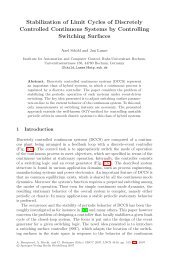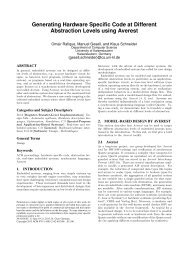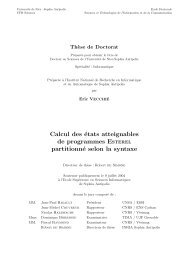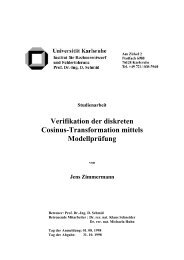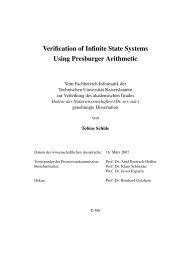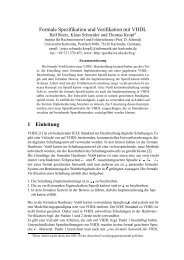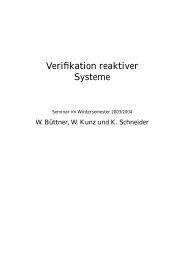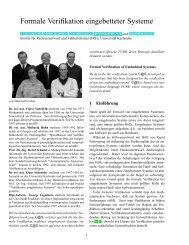Evaluation Environment for AUTOSAR-Autocode in Motor Control ...
Evaluation Environment for AUTOSAR-Autocode in Motor Control ...
Evaluation Environment for AUTOSAR-Autocode in Motor Control ...
You also want an ePaper? Increase the reach of your titles
YUMPU automatically turns print PDFs into web optimized ePapers that Google loves.
Chapter 1<br />
Introduction<br />
1.1 Motivation<br />
The <strong>in</strong>creas<strong>in</strong>g complexity of embedded systems found the way <strong>in</strong>to automotive development<br />
some years ago. The number of electronic control units (ECU) has <strong>in</strong>creased<br />
to about 70 and they are connected by about 5 system buses per car [11]. However,<br />
not every component comes from the same manufacture, <strong>in</strong>stead the whole hardware<br />
and software system of a car is composed from different suppliers.<br />
The <strong>in</strong>creas<strong>in</strong>g complexity has to be handled together with the needs to be compatible<br />
with other manufactures to keep the development ef<strong>for</strong>t down. To achieve<br />
these goals there was still an attempt to standardize software done with OSEK/VDX<br />
[13]. These first reached goals are now cont<strong>in</strong>ued by the Automotive Open System<br />
Architecture (<strong>AUTOSAR</strong>) [9].<br />
However, the migration to such a standard has to be done and s<strong>in</strong>ce there is a lot<br />
of exist<strong>in</strong>g software, which should not be discarded, a way must be found, to do such<br />
a migration <strong>in</strong> little steps.<br />
1.2 Related Work<br />
For embedded system, automatic code generators play a significant role. They provide<br />
the creation of code from a configuration or a model and prevents errors from hand–<br />
written code. However, it is required, that the code generators conta<strong>in</strong> no errors and<br />
produce correct code, which reflects the configuration.<br />
For develop<strong>in</strong>g software <strong>for</strong> embedded devices the model<strong>in</strong>g tools ASCET[20] and<br />
MATLAB/Simul<strong>in</strong>k/Stateflow[21] exist. ASCET provides its own code generator to<br />
create source code from the model. The software TargetL<strong>in</strong>k[23] from dSPACE is<br />
typically used to generate code from MATLAB/Simul<strong>in</strong>k/Stateflow models.<br />
The tool MTest[22, 17], which is also provided from dSPACE, is used to test the<br />
models <strong>in</strong> different development phases. Other works deal with the test<strong>in</strong>g of the code<br />
generators itself[24, 26, 25]. However, these works assume that the semantic is def<strong>in</strong>ed<br />
and the behavior of the generated code can be compared to that of the model. The<br />
works also do not handle the aspect of <strong>in</strong>tegration of the generated code <strong>in</strong>to another<br />
enviroment.<br />
Another tool <strong>for</strong> test<strong>in</strong>g embedded software, which is also based on XML configurations,<br />
is described <strong>in</strong> [18, 10]. However, it handles test<strong>in</strong>g of source code and does<br />
1




